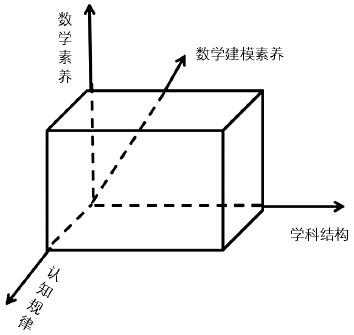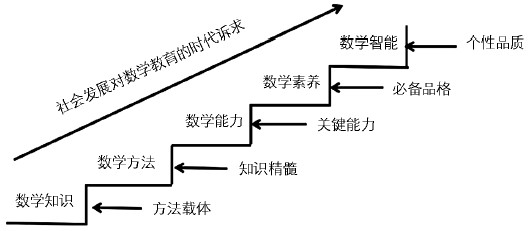全文HTML
-
2017年,亦即“核心素养”在官方文件中正式提出三年后,教育部研制出版了《普通高中数学课程标准(2017年版)》(以下简称“新课标”),正式将数学建模素养列为六大数学核心素养之一,把数学建模与数学探究作为贯穿新课程内容的四条主线之一。此外,新课标详细阐述了数学建模的主要过程、表现以及意义,并将其划分为不同的层次水平[1],既有从学科素养到培养目标的质性描述,又有从课程结构到评价体系的设计。这意味着普通高中数学课程内容与教育理念发生了深刻变化,唯有承前启后,方能继往开来。追溯数学建模素养的渊源,主要有三条线索。
第一条线索是各国国家数学课程标准的变化。在我国,主要是教育部/国家教委(1985年—1998年)制定的数学课程标准(2001年前为数学教学大纲)。对于初中学段的数学教育,教育部于2001年研制印发了《全日制义务教育数学课程标准(实验稿)》,在课标“前言”部分,明确提出“数学模型是描述与刻画自然现象和社会现象的工具”,并强调“建立数学模型,进而解决问题”[2]。《义务教育数学课程标准(2011年版)》在“课程内容”部分,明确要求学生初步形成数学模型思想,指出模型思想有助于提升学生数学应用意识和数学学习的兴趣,是学生理解数学和外部世界之间联系的基本途径[3]5-7。针对高中学段的数学教育,具有纲领性的文件是国家教委基础教育司于1996年编订的《全日制普通高中数学教学大纲(供试验用)》,其第四部分——教学中应该注意的几个问题——中的“坚持理论联系实际”一节,提出“能初步运用数学模型解决某些实际问题”[4]。2003年,教育部研制印发《普通高中数学课程标准(实验)》,在“课程的基本理念”部分提出“开展数学建模学习活动”,在“课程设计思路”部分提出“将数学建模的思想渗透到各专题与模块内容中”[5]。2014年3月,《教育部关于全面深化课程改革落实立德树人根本任务的意见》出台,其中强调,当前课程要依据学生发展核心素养体系,并在整体设计前提下,优先启动普通高中课程标准的研制与修订工作[6]。正是在这样的背景下,教育部启动了普通高中数学课程标准修订工作,并经过课题组的多次论证,“数学建模素养”被正式纳入新版数学课程标准,且成为六大学科核心素养之一。
在国外,美国高中数学课程标准将“数学建模”作为衡量数学实践过程的八个指标之一,并对数学建模和具体的数学知识内容提出了不同的要求[7]。美国高中数学课程注重数学建模思想和方法的综合运用,数学建模思想几乎贯穿全部的数学主干内容,同时强调系统构建数学建模的思想方法体系[8]。英国的中学数学课程分为五大领域,其中“实验与应用数学”领域就含有数学建模内容。德国高中数学课程标准将数学建模作为衡量数学能力的六大维度之一,并对不同水平的数学建模能力给出了详细而具体的界定[9]。王林全教授认为,若说美国将数学建模内容主要安排在高中学段,那么德国则把数学建模安排在了整个中学阶段,并将数学建模作为促进学生热爱数学、钻研数学的一条路径[10]。俄罗斯高中数学课程有两种不同的标准:基础水平和高水平,其中高水平的数学教育目标要求学生能够应用数学模型解决常规及非常规问题[11]。在丹麦,数学建模与数学思维、问题解决、数学推理等能力被共同归入同一个数学能力群,并将其作为高中数学课程重要内容[12]。事实上,在国际领域,诸如美国、英国、德国、俄罗斯、芬兰、丹麦等西方国家,均将数学建模及其模型思想纳入了国家数学课程体系。
第二条线索是由国际组织编制和实施的测评体系及其相关研究。国际学生评估项目(PISA)是国际上比较有影响力的测评系统。PISA2018数学测评样题显示,该项目将数学建模能力作为了数学素养评价的重要内容,同时它也是衡量数学过程的八项能力之一。在国际教育成就评价协会(IEA)主持及研发的国际数学与科学评测趋势项目(TIMSS),数学测评属于该项目评估与研究的核心领域。在认知与过程方面,其测评体系较为关注问题解决能力,尤其是基于现实情境的问题解决素养方面的测评。如TIMSS2015(八年级)测评样题显示,解决常规问题的认知过程,包括对问题的识别、建立数学模型、数学知识方法的应用、对结论的检验及判断等,已成为该评测体系所关注的重点。全美评估管理委员会主导的国家教育进展评估项目(NAEP)旨在测评美国学生在不同的三个年级段的最新教育状况,数学与科学是其中重要测评领域,主要检测学生的数学推理能力,利用数学知识进行科学探究,建立假设、控制变量、数据解释,尤其是数学应用与问题解决能力。如NAEP2013数学测评试题即注重问题情境、凸显数学应用[13]。NAEP数学试题关注试题的真实情境,注重从情境中挖掘有效信息,利用已有的数学知识解决问题。这样的试题设计就比较契合数学建模的思想方法。
第三条线索是各类学术团体组织的数学建模活动及赛事。早在20世纪70年代,西方国家就开始着手开展数学建模活动,并建议将数学建模活动纳入中学课程。由国际数学教育委员会主办的国际数学教育大会(ICME)自20世纪80年代起,其组织者及参会者就曾多次强调数学教育需要关注数学建模活动。如在2012年的第十二届国际数学教育大会上,组织者即安排了多个有关数学建模项目的报告[14]。2016年,第十三届国际数学教育大会在德国著名数学家F.克莱因的家乡举办,会议专题研究组12个主题板块之一的“数学能力与思想方法”中,即有“数学教与学中的数学应用与建模”研究项目[15]。随着信息技术的发展,各种数学建模赛事也应运而生。其中美国大学生数学建模竞赛(MCM/ICM)是比较有影响力的国际性数学建模赛事,2020年,有来自世界各地的2万多个团队、共计6万余名选手报名参赛。在我国,20世纪90年代,由国家教委高教司牵头,联合中国工业与应用数学学会,共同举办了首届中国大学生数学建模竞赛,此后每年一届,参赛单位及选手逐年增多,已成为全国高校规模最大的基础性学科竞赛。2020年3月,广东省教育研究院与北京师范大学数学科学学院联合举办了高中数学建模课堂教学设计交流活动。活动聚焦广东省高中数学建模课堂教学,开展了相关的数学建模教学研讨和学术交流活动,并面向全省征集优秀的数学建模教学设计作品。
数学建模活动始于20世纪70年代,经过几十年的发展,已从早期学术研究领域中的微专题上升到国家统编课程体系中的重要内容,从先前局域性建模赛事发展成为国际性知名测评项目中重要的评测维度,由最初的“星星之火”发展到当今全球“遍地开花”。无论是理论建构还是实践行动,数学建模都得到了迅速的发展。也正是因为此,数学建模素养被纳入数学素养体系,并成为其核心组成部分。从国际比较的视野审视数学建模素养,需要厘清其来龙去脉、实质意涵以及建构路径。鉴于此,笔者试图采用理论思辨及文本分析的方法,探讨如下问题:一方面,数学建模素养因何而走进数学课程体系,其应力主要来自哪些场域,它的实质意涵包含了哪些方面;另一方面,数学建模作为重要的数学素养,其生成机制与建构路径如何厘清。
-
深度把握数学建模素养的本质意涵是建模素养研究的一个逻辑起点。不仅需要梳理其理论与实践的发展脉络,更需要对其出场的缘起、演进及内涵发展有一个清晰的认知,这也是研究数学建模素养的理论根柢。数学建模素养的提出有着深刻的学科背景、时代内涵,也符合认知规律。从出场学的视角看,数学建模素养的出场语境主要源于外界的应然诉求和自身的价值特性。如果把数学建模素养当作一个新型张量,那么这个张量就受到其维度内各个分量间的相互作用。数学建模素养这一张量主要由数学学科结构、数学素养以及认知规律三个分量所合成,如图 1所示。
-
数学是人类对世界直观感知、高度抽象以及理性认识的产物。从传统数学领域到现代新兴领域,数学体系目前已可细分为十几个分支,远远超出以往关于数量关系与空间结构的研究范畴。从宏观结构上看,数学学科可以粗略地分为纯粹数学(数论、群论、数理逻辑、非欧几何等)和应用数学(数理统计、运筹学、信息论、模糊数学等),而且这两者是一个有机整体,共同构成数学体系的根基。应用数学的飞速发展源自于解决问题的迫切需要,而数学建模是应用数学联系现实世界的重要纽带。数学建模不仅是自然科学与工程技术的必要工具,而且已逐渐渗透到人文社会科学以及新兴学科领域。数学建模是数据处理、量化分析、优化决策、理论模型建构的重要手段。数学建模的思想方法是数学学科技术转化为实践应用的重要利器,它深刻影响着现实问题解决的门径选择以及其他学科的发展形式。数学建模作为一种重要的数学结构,不断牵引着数学向前发展,同时也正是因为有这股力量的牵引,才使得数学在不断创建与超越的道路上得到发展。
一方面,建模素养是一种重要的数学技能,其成为现代公民综合素质的重要组成,离不开应用数学发展的内在驱力;另一方面,人们在解决现实问题的过程中,随着建模技能的提升,加深了对数学知识与方法的理解及其应用,不断发现与提出新的数学问题,从而反过来又促进了数学的发展。所以,数学内部结构的重组与改进促使数学学科发展方向趋于多元化,从学科内研究迈向跨学科研究,进而推动着应用数学尤其是数学建模飞速发展。数学建模也逐渐突破传统范畴,几乎渗透到人类所有的知识领域。在学科发展的背景下,从数学学科向其他学科如计算机数学、生物数学、物理数学、数理经济学等交叉学科的渗透,再到独立应用学科如运筹学、控制论、数理统计学等学科的形成,数学建模都发挥着不可代替的作用,同时它也是应用数学发展过程中不可或缺的必备工具。
-
早在20世纪六七十年代,学者们即开始提出“数学素养”,此后逐渐受到西方国家数学教育家的青睐。21世纪初,数学素养研究开始成为热点。得益于国际性测评项目,尤其是国际学生评估项目(PISA)和国际数学与科学评测趋势项目(TIMSS)的广泛影响,无论是国内还是国外,数学素养研究势头都日趋强劲。从数学知识技能到数学思想方法,从数学能力再到数学素养的提出,都折射出人们对数学教育内涵认识的不断提升。从静态的数学知识技能的传授到数学思想方法的提炼,从单纯数学能力的培育到数学情感品格的升华,社会发展对数学素养的需求越来越迫切,内涵也越来越清晰。如图 2所示,数学知识是数学教育的逻辑起点,也是数学思想方法的载体。数学思想方法是数学知识的内蕴和精华,数学能力是数学素养的核心要素,它能够反映对于数学知识及数学思想方法的深层次理解、迁移和创新。数学素养是数学能力、数学情感及其价值的综合体现,是对现代公民的基本要求,是现代公民在熟悉情境下能够应用数学、体验数学、感悟数学的一种能力品质。数学智能则是对拔尖人才的培养要求,其情境更为复杂、综合,其要求已超出数学范畴本身,是对个体数学认识论、方法论以及个性品质的一种综合测度。
随着数学素养研究的深入推进,学术界也涌现出许多有关数学素养的结构模型和评价体系,并将数学建模能力指标维度纳入其中。如史宁中教授认为,普通高中数学课程标准(2017年版)设计的学科核心素养的本质就是抽象、推理及模型,而且数学模型是一种基本的数学思想,它与抽象、推理一同构成数学思想的三大核心要素[16]。数学教育的发展必须反映时代发展的诉求。建模素养进入数学核心素养体系,既符合社会发展实际需要,也顺应新课程改革要求。伴随着现代信息技术与人工智能的发展,数学建模的思想方法逐渐成为学科技术转化为实际应用的关键路径,建模素养养成也成为创新型人才及复合型人才培养的重要环节。
-
施良方教授认为,学习是由经验引起的,学习结果是学习者行为、能力或心理倾向发生的一种相对持久的变化[17]。进入21世纪,我国基础教育对数学学习的要求发生了重要改变:由原来单一的“双基”框架(基本知识与技能)升华为立体的“四基”体系,在强调“双基”的同时,又关注到基本思想与基本活动经验[3]8。事实上,学习的本质就是一种变化。这种变化不是瞬间的,而是相对持久的;不是固化静态的,而是可迁移的;不是外显的,而是内隐的;不是统一模式的,而是带有学科属性的。学习产生的主要条件是活动经验,而不是生理成熟、药物刺激、基因病理抑或特异功能等。在数学学习领域,学习变化主要表现为三个方面,即心理认知、个体行为和能力品格的变化。既有认知因素的变化,也有非认知因素的变化,可以归结为数学认知的产生、技能的习得、数学能力的生成、数学情感的升华、行为方式的改善等。
美国著名数学教育家M·克莱因先生认为,真正的知识都来源于经验,并对所积累的材料进行严格的思考和理论化。这些都是通过直觉与抽象而获得的。基本的数学观念虽由心智构造而成,但都可以追溯到现实经验[18]。虽然说现代数学某些分支的发展趋势是具有更高的抽象性,但任何抽象物都不是独立于人脑而存在的。数学诞生于现实生活,但当数学发展到一定程度时,在一定的规则和结构下,会构造出超越或脱离现实世界的抽绎物。但这并没有否定人类认知是从直观经验开始的,理性认知也不可能完全脱离感性认识。更高抽象物也是从简单观念、基础知识、现实世界中产生的,它们是不断重构组合、抽象升华、持续飞跃的结果。如,无理数源于几何图形和二次方程根的发现;虚数与群论源于对高次方程代数解的探索;微积分的建立源于对极限思想、变量关系、曲线度量、非匀速运动等认知成果的不断积累;非欧几何、四维空间的创设,源于对欧氏几何公理、曲面理论、时间轴(借助时间描述空间)的深层次认知。
所以,数学建模并非靠纯粹的理性认知来验证与求解现实中的问题,而更多是利用数学假设、测量、推理、运算得到一些经验数据,为现实问题拟合出近似或具有类比性的解决方案及解释视角。从本质上说,数学学习是人类的一种活动,数学建模素养的习得、数学方法及技能的掌握都源于学习者的活动经验。数学建模也不过是凭借现实经验而抽象出的一种数学结构,是对现实问题一种近似的、理想化的表征。重视数学建模素养的培育,也是始于人们长期以来对数学学习方法的深度认知。数学建模素养并不是凭空产生的,也不是靠做大量的数学试题就能训练出来的。它深受学习者所生长的文化环境和数学语境的影响,是在学习者数学活动经验及鲜活的数学语境中生长出来的。如果不考虑学科特性和认知规律,将数学建模简单归结于纯逻辑的陈述、解题训练抑或虚拟游戏,那便是对认知规律和学习方法的无视与罔顾。
一. 学科结构:数学发展的内在驱力
二. 数学素养:时代发展的应然诉求
三. 认知规律:学习本质的深刻把握
-
数学建模活动是数学知识与数学应用间建立联系的纽带,也是形成数学建模素养的媒介与载体。数学建模素养来源于数学建模活动,同时又高于数学建模活动,没有形成建模素养的建模活动毫无意义。建模素养不是建模活动在人脑中原封不动的再现,而是对建模活动的一种质的提升。数学建模素养是从数学建模活动中习得的数学知识技能、掌握的数学方法、生成的数学能力、形成的数学情感与价值观等。因此,数学建模素养蕴含了个体对数学建模活动的本质认识,包涵个体从某些具体建模活动中所提炼、升华的数学思想、数学精神以及数学观念等。数学建模素养的意涵是多元的,包括数学想象、问题解决、数学交流、数学化能力等基本要素。
-
所谓数学建模活动,就是从现实情境中简化、抽象出数学问题及结构,采用数学模型与结构进行拟合、分析,最后通过模型的求解及验证,得出对原问题的解释或预报。数学建模是针对现实情境的结构特征,对其情境本质进行抽象概括和数学表征。创建数学模型的目的就是利用数学方法的高效性与系统性解决现实问题,其活动本质是合规律性与合目的性的统一。
数学建模活动是孕育建模素养的母体,是联结数学内部与数学外部的重要纽带,其活动具有情境性、过程性、有效性、结构性、双重性、合作性及实践性等多重特征。首先,数学建模具有情境性,不是纯粹的数学内部探究活动。作为数学方法,它最大的特点就是从现实世界中抽象出数学研究对象,区别于公理化方法(采用纯粹逻辑推理的系统演绎格式)。其二,数学建模活动是一个完整的过程。按照新课标中的建模流程图,可以将建模过程归纳为三大环节:数学问题的确立(现实情境、发掘问题、表征问题)、问题的处理(剖判问题、设计参数、构建模型、分析运算)、问题的解答(结果检验、改进模型、结论阐释)。其三,数学建模的结果并非真理,只是现实情境与数学结构的一种拟合与假设,需要经过实践过程的循环检验。一方面,这种拟合过程是一种理想化状态,其拟合效果的检验也是一个逐渐逼近真理的动态过程;另一方面,它具有工具性及有效性。作为问题解决的一种工具,它有助于人们处理许多现实问题,而且为人们解决现实问题提供一种建设性视角。其四,数学建模是一种解决问题的思路与方案,具有一定的结构性。数学语言、数学抽象与数学方法是数学建模结构的三大核心要素。其五,数学建模具有双重性,既是现实问题向数学模型建构的数学化过程,又是一个数学模型结果向现实问题转化的解释与验证过程。其六,建模活动具有合作性。从选题到结题,从模型创建到反思完善,数学建模活动都是一个师生之间、同伴之间相互交流的过程,既有专题式的分工合作,又有课题式的综合协作。其七,数学建模活动是一项综合性实践活动,社会实践性突出,有别于其他的数学内部活动。
-
数学建模素养作为建模活动过程所产生的结果,既体现了数学活动的思维工具价值,又体现了现实生活中的社会人文价值。它的构成要素主要包括四个方面:数学化能力、多元想象能力、问题解决素养、交流合作素养。
-
极具国际影响的数学教育家弗赖登塔尔(H.Freudenthal)先生关于数学教育的重要观点就是数学化与数学现实。弗赖登塔尔强调数学源于现实生活并应用于现实生活,主张采用数学思想方法观察世界、分析问题、解决问题。他认为,学习数学的过程就是形成数学化思维的过程。所谓数学化过程,就是将现实情境转化与抽象为数学问题,并利用数学结构加以解决的过程,如图 3所示。建模素养与数学化能力有着密不可分的联系,数学建模是数学化的重要形式,数学化能力是建模素养的内核。
-
爱因斯坦曾说过,想象力远高于知识,想象力是无穷无尽的,也是知识的源泉。数学建模是一种简化的、理想化的形态。它既是数学应用意识的体现,又是现实情境与数学结构拟合的过程,更是知识创新及再生产的过程。这种拟合过程也是一种数学想象活动。为了更好地描述现实世界的问题与规律,需要多元的想象能力和多维度、跨领域的视角。如:在现代经济学中,开创性地采用博弈论分析经济生活中的个体行为;在政治学中,利用集合与函数理论分析集体决策及选举规则问题;在社会学中,应用统计回归模型分析种群差异等问题;在物理学中,利用三角函数与向量研究导弹发射行程问题;在生物学中,利用概率论解读基因序列及遗传病问题,等等。可见,现实情境与数学模型的拟合、匹配,往往都需要具备多角度、跨领域的想象能力。
-
数学作为一门工具性学科,最集中的体现就是解决问题。问题解决素养是一种普遍适用的能力,是将现实问题转换为数学对象的能力,是构建模型与解决问题的一种修养。通过数学建模活动,可让个体理解建模工具的内涵与意义,运用建模的一般方法解决现实生活中的各类问题,并尝试运用建模思想方法解释社会生活中的各种现象,发现科学规律。在新课标中,提出“四能”的核心为问题解决能力,问题解决素养是现代公民的基本素养和必备素质。而数学建模活动的根本目的就是解决问题,就是培养个体运用数学语言和数学方法,描绘问题、分析问题、解决问题的能力。
-
数学建模活动主要是围绕某个现实生活中的问题,以课题研究的形式开展。在活动过程中,主要通过合作分工、同伴交流的方式经历数学建模的过程。其间,对数学对象的抽象概括、对数学模型的创设构建、对数学方法的综合运用等,都需要较高的数学表征能力和数学语言交流能力。在交流过程中,个体既要能够准确清晰地表达自己的观点,又要能积极倾听和理解同伴的想法,进而才能相互信任、相互协助、共同进步。因此,通过经历数学建模的过程,可以让参与者感悟数学的魅力,体验交流与合作的重要意义。
一. 数学建模活动的内涵特征
二. 数学建模素养基本要素的内涵
1. 数学建模素养是一种数学化能力
2. 数学建模素养是一种多元想象能力
3. 数学建模素养是一种问题解决素养
4. 数学建模素养是一种交流合作素养
-
数学建模素养是一种综合性素养,其生成建立在数学建模活动经验基础之上,体现为通过数学建模活动而产生的认知、情感、学习体验以及精神感悟等。建模活动是生成建模素养的载体,是积累、拓展、深化数学经验的纽带。数学建模素养的生成与培育路径应从课程、教学、学习、师资等四个层面展开,具体见表 1。
-
数学的发展并非原地打转或画地为牢,而是积极渗透到社会生活的各个领域。数学学习活动也不能处于一个真空地带,而是需要紧密地联系实际生活。数学建模的逻辑起点是现实情境,需要熟悉、理解现实世界中的各种情境,并对其加以深度分析,这种分析既包括定量刻画,又有定性把握。数学建模是从现实情境中发现问题与提出问题,并将各种情境中的事物关系进行抽离、概括和转化,运用数学语言将其表征为数学关系。数学不是一门封闭的科学,它与许多学科彼此关联、共同发展。因此,促进跨学科课程的交融是培育个体建模素养的一个重要方式。新课标强调重视社会实践与数学文化,将数学综合实践活动和数学文化融入课程内容,以丰富学生的数学知识,提升其社会实践能力。同时,通过数学和其他学科课程的融合,可以让学生从其他学科课程中汲取营养,增强其数学应用意识和建模素养。人类所创造的知识并不是完全孤立的,而是一个立体的、不断交融生长、无限拓展延伸、多层次发展的巨型网络。数学知识即是与其他学科知识一道通过各层网络结点,按照一定内在逻辑关系“镶嵌”起来的。通过设置跨学科课程,可以拓宽学生的视野,让其理解数学与其他学科之间的联系,从而进一步突出数学的应用性和功能性。如果跨学科课程知识与数学知识发生了联结,那么数学建模活动就能够发挥重要作用,将数学知识原理与其他学科知识紧密联系起来,为人们提供问题解决的可行思路与方法。同时,跨学科课程交融共生,还可以有效打破专科专教的壁垒,提升学生的综合素养,帮助个体更好地适应与融入未来的社会生活。
-
建模活动是一项重要的数学活动,对发展学生数学思维、问题解决能力、多元想象力有着重要作用。它的功能价值远非传统僵化教学模式所能比拟,对建模活动的教学取向应是生成的、积极导向的、合作探究的、以智育情的。数学建模教学不是一味地实施题海战术,片面做题是一种短视的教学行为,对学习者的持续发展是非常不利的。数学教育的最终目的是培养现代社会的合格公民,而不是解题机器。因此在教学层面,培育建模素养最主要的是引导学生形成数学建模的思维方式。首先,教学设计要关注建模活动,加强建模教学指导,开展建模与探究活动。新时代,更需要学生的团队意识,重大的科学探究往往都不是个人单枪匹马所能完成的,而是需要跨领域的团队协作。通过建模教学活动,可以增进同伴之间的交流与合作,培养同伴之间的合作意识。其次,在教学中,要从数学思想、数学文化的视角开展建模活动。数学是一种文化。它源于现实,寓于文化,同时交融于文化。数学回归现实,应用于现实,更是文化的传承与创新。数学也是一种思想。因此,应充分挖掘每一个数学模型背后所蕴藏的数学思想方法,如数学抽象、数形结合、等价转化等,这些都是建模活动的思想底蕴[19]。最后,日常教学渗透与主题单元教学是建模素养培育的主要路径。一方面,建模素养的培育不是一朝一夕的事情,它需要日常教学的不断渗透和持续推进;另一方面,定期开展建模主题单元教学活动以及项目式教学,在做中学,通过集中式建模实践活动,培养学生的抽象思维以及数学化能力。
-
建模素养培育中的一个核心要素就是对认知规律的深刻把握。学生能够构建新的数学模型,是建立在背景知识储备(最近发展区)的基础之上的。建模活动的本质就是积累鲜活的数学经验,唤醒学习者的主体意识,使学习者大脑内的神经细胞发生新的联结。让新的学习经验融入原有经验中,让新知识进入学习者原有的知识体系,这才是真正意义上的建模活动。建模活动的目的是解决现实世界中的问题,只有运用学习经验去解决现实问题,建模素养才可能生成与巩固。然而,在现实的学习中,往往会发生主体错位的情形。目前,比较受欢迎的学习方式有深度学习、项目式学习、合作学习、发现学习、探究学习、自主学习、研究性学习、个性化学习等,但不管是哪一种学习方式,如果忽略了学习者的主体意识,就不是真正的学习,更称不上是有意义的学习。在建模活动中,应增强学习者的主体意识,加强课堂内外的实践活动。一方面,关注建模活动的应用性和创新性。建模活动是人类心智的产物,只有激发学习者的好奇心与求知欲,才能唤醒学习者的主体意识。另一方面,建模活动是同伴间共同学习、共同建构的成果,因此应促进学习者的乐群性,使其充分体验到在群体中相互协助、共同进步的乐趣。
-
新时代对数学教育提出了更高的要求,且不同的数学活动对教师素质的需求也不一样。虽然一些学校也曾开展过零星的建模活动,但建模素养是近些年才被正式纳入新课标中,因此需要数学教师更新建模教学理念以及评价理念,加强有关数学语言、数学方法、数学建模等方面的修养,尤其是要深化建模认知信念,提升素质、改进教学。在建模活动中,要关注学生必要的知识储备,建模题材要贴近学生的生活实际,注重建模思维的引导,充分发挥学生的主体意识。在评价过程中,坚持评价方式多元化,关注建模过程评价及情感因素评价。
综上所述,虽然世界各国对如何开展数学建模教学仁智各见,但都非常注重建模素养的培育。深挖建模活动的缘起与发展脉络,可以发现建模素养背后的三股应力。建模素养的本质是丰富的,包括数学化、多元想象、问题解决以及交流合作等多重意涵。建模素养的培育路径可以从课程、教学、学习以及师资等四个层面展开。建模活动的存在价值远超传统应试教学的范畴,应通过有策略、多视角的教学行为培育学生的建模素养,充分发挥建模活动的应用价值。




 下载:
下载:

